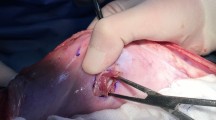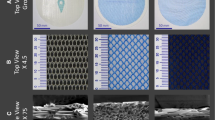Abstract
Background
The purpose of this study is to evaluate fixation methods for polytetrafluoroethylene (ePTFE) mesh with an in vivo model of laparoscopic ventral hernia repair.
Methods
In 40 New Zealand white rabbits, a 4 × 4-cm ePTFE mesh (n = 80, two per animal) was attached to an intact peritoneum with polyglactin 910 (PG 910) (n = 20) or polypropylene (PP) (n = 20) suture, titanium spiral tacks (TS) (n = 20), or nitinol anchors (NA) (n = 20). Mesh was harvested at 8 and 16 weeks for fixation strength testing, adhesion assessment, and collagen (hydroxyproline) content. Fixation strength on day 0 was determined with mesh attached to harvested abdominal wall. Statistical significance was determined as p < 0.05.
Results
There was no difference in fixation strength between PP (39.1 N) and PG 910 (40.0 N) sutures at time zero. At week 8, PP (25.7 N) was significantly stronger (p < 0.05) than PG 910 (11.4 N) suture, but not at week 16. The fixation strength of TS and NA (day 0, 15.4 vs 7.4 N; week 8, 17.5 vs 15.3 N; week 16, 19.1 vs 13.8 N) was not significantly different. Fixation with PP suture was significantly (p < 0.05) stronger than that with TS and NA at day 0 (39.1, 15.4, and 7.4 N, respectively) but not at weeks 8 or 16. The fixation strength of suture decreased significantly (p < 0.05) from day 0 to week 16 (PP: day 0 = 39.1 N, week 8 = 25.7 N, week 16 = 21.4 N; PG 910: day 0 = 40.0 N, week 8 = 11.4 N, week 16 = 12.8 N). The fixation strength of NA and TS did not change significantly (NA: day 0 = 7.4 N, week 8 = 15.3 N, week 16 = 13.8 N; TS: week 0 = 15.4 N, week 8 = 17.5 N, week 16 = 19.1 N). There were no differences in adhesion area based on fixation device used; however, there were more (p < 0.05) mesh samples using NA with adhesions compared to TS and adhesion tenacity was greater (p < 0.05) compared to that of TS, PP, and PG. Hydroxyproline content at weeks 8 and 16 was similar for all fixation devices.
Conclusions
The initial fixation strength for nonabsorbable suture is significantly greater than that of the metallic fixation devices, but after 8 weeks there is no difference. Laparoscopic ventral hernia repair without transabdominal suture fixation may be predisposed to acute failure. The metallic devices have similar fixation strength, although the incidence of adhesions and tenacity of adhesions appear to be greater with the nitinol anchors. Since these devices have similar fixation strengths and most likely provide adequate supplementation to transabdominal sutures for mesh fixation after laparoscopic ventral hernia repair, their use should be based on other factors, such as their propensity for adhesions, ease of application, and cost.








Similar content being viewed by others
References
MA Carbajo JC Martin Olmo Particledel JI Blanco (1999) ArticleTitleLaparoscopic treatment vs open surgery in the solution of major incisional and abdominal wall hernias with mesh Surg Endosc 13 250–252 Occurrence Handle10.1007/s004649900956 Occurrence Handle10064757
AM Carbonell KL Harold AJ Mahmutovic R Hassan BD Matthews KW Kercher RF Sing BT Heniford (2003) ArticleTitleLocal injection for the treatment of suture site pain after laparoscopic ventral hernia repair Am Surg 69 688–691 Occurrence Handle12953827
InstitutionalAuthorNameCommittee on Care and Use of Laboratory Animals (1996) Guide for the care and use of laboratory animals U.S. Department of Health and Human Services, Public Health Services, National Institute of Health Bethesda, MD
CL Garrard RH Clements L Nanney JM Davidson WO Richards (1999) ArticleTitleAdhesion formation is reduced after laparoscopic surgery Surg Endosc 13 10–13 Occurrence Handle10.1007/s004649900887 Occurrence Handle9869679
BT Heniford A Park BJ Ramshaw G Voeller (2003) ArticleTitleLaparoscopic repair of ventral hernias: nine year’s experience with 850 consecutive hernias Ann Surg 238 391–399 Occurrence Handle14501505
C Karokousis C Volpe J Tanski (1995) ArticleTitleUse of a mesh for musculoaponeurotic effects of the abdominal wall in cancer surgery and the risk of bowel fistulas J Am Coll Surg 181 11–16 Occurrence Handle7599765
N Katkhouda E Mavor (2001) ArticleTitleUse of fibrin sealant for mesh fixation in laparoscopic extraperitoneal inguinal hernia repair Ann Surg 233 1–11 Occurrence Handle11141218
Z Kaufman M Engelberg M Zager (1981) ArticleTitleFecal fistula: a late complication of Marlex mesh repair Dis Colon Rectum 24 543–544 Occurrence Handle7028427
M Van’t Riet PJ Vos Steenwijk Particlede van GJ Kleinrensink EW Steyerberg HJ Bonjer (2002) ArticleTitleTensile strength of mesh fixation methods in laparoscopic incisional hernia repair Surg Endosc 16 1713–1716 Occurrence Handle10.1007/s00464-001-9202-7 Occurrence Handle12098028
ER Winslow S Diaz K Desai T Meininger NJ Soper ME Klingensmith (2004) ArticleTitleLaparoscopic incisional hernia repair in a porcine model: what do transfixation sutures add? Surg Endosc 17 .
Acknowledgment
This work was funded by a grant from the Society of American Gastrointestinal Endoscopic Surgeons.
Author information
Authors and Affiliations
Corresponding author
Rights and permissions
About this article
Cite this article
Joels, C.S., Matthews, B.D., Kercher, K.W. et al. Evaluation of adhesion formation, mesh fixation strength, and hydroxyproline content after intraabdominal placement of polytetrafluoroethylene mesh secured using titanium spiral tacks, nitinol anchors, and polypropylene suture or polyglactin 910 suture. Surg Endosc 19, 780–785 (2005). https://doi.org/10.1007/s00464-004-8927-5
Received:
Accepted:
Published:
Issue Date:
DOI: https://doi.org/10.1007/s00464-004-8927-5




